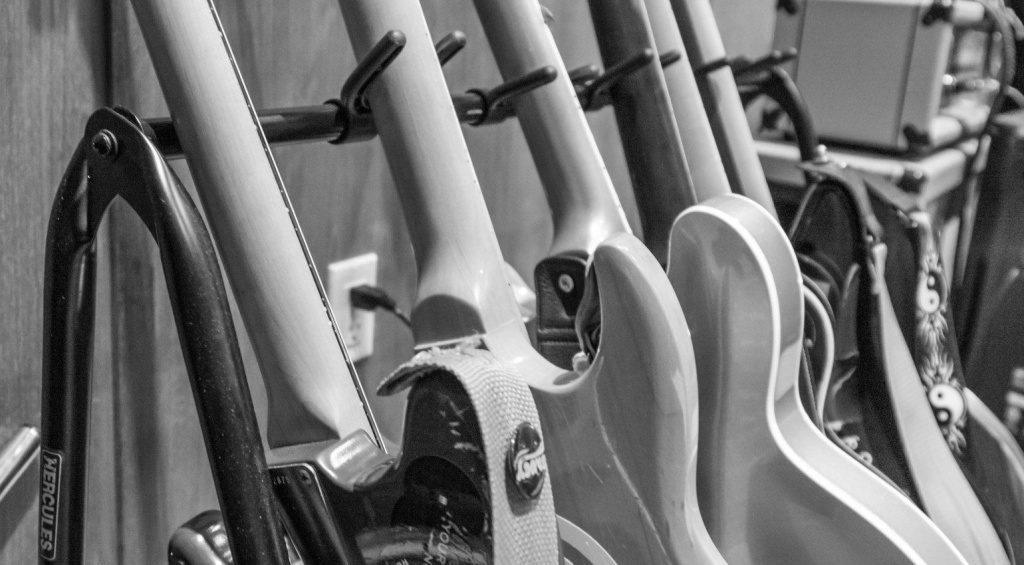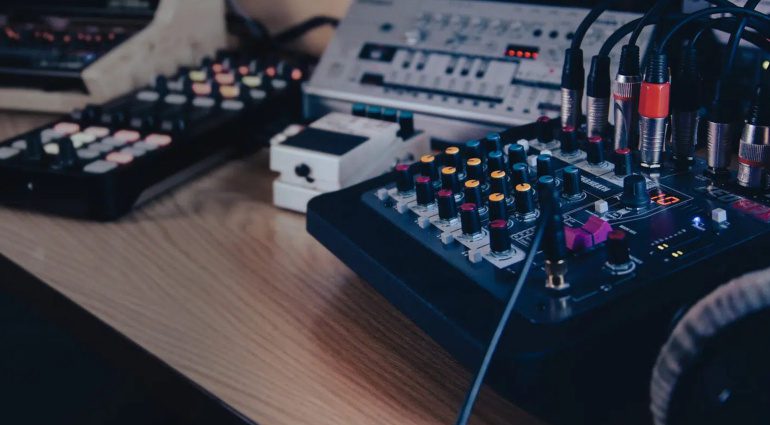- What awaits you in this article “How many guitars do you really need?”
- Too many? Or not enough?
- How many guitars do I really need – the situation
- Which guitars are important. And why.
- Why just one guitar is not enough & how many guitars do you really need?
- How many guitars should I own?
- 10 classic guitars that always work
- How many guitars do I need – how many guitars do you need?
- More on Fender and Gibson
I have owned about 40 guitars over the years. Today, there are 10 left—divided equally between those I regularly play and my little “collection.” Like most guitarists, I would have answered the question, “How many guitars is enough?” with a clear “One more than I already have.” until recently. But is more really better? Or could the number of instruments start interfering with your ability to be a good guitarist?
Originally published at Gearnews.de by Jan Rotring. Translation by Julian Schmauch.
Guitars are my absolute passion. I don’t just love the electric guitar as a musical instrument and a means of creative expression. I also like it as an object: the combination of wood, simple electronics, and maximum precision fascinates me. But if you look at it soberly, the guitar is, first and foremost, a tool, and we should use it to make music. So one evening, I sit in my little studio and look around — the beginning of a (small) existential crisis.
What awaits you in this article “How many guitars do you really need?”
Too many? Or not enough?

There they all are: dutifully standing on shelves, lying in boxes, hanging on the wall. There’s also one (or two) in the living room and in the rehearsal room, but I need them there, too.
The purely practical benefit of having lots of different guitars is also quite obvious. Whenever the creative spark ignites in my home (rarely), there’s always an instrument within reach, and I can start tinkering with the idea.
And yet, I quickly reach my limits — on the one hand, this may be due to my musical abilities. On the other hand, there’s always the thought: “Yes, yes, but I should play that on the Les Paul”. Then, the thought turns away from the product and towards the endless possibilities. And that’s usually the end of my creativity because it’s also clear that this one guitar that I absolutely (urgently, urgently, oh my God GAS!) have to have is missing.
To put it in a nutshell, my drastic reduction in owning guitars is related to this very hamster wheel. I approached the question of how many guitars it makes sense to own from a different angle and took a more analytical approach.
How many guitars do I really need – the situation
At the very beginning of my cleaning up, I want for two categories – Playing and Collecting. Of course, there may be some overlap, but basically, I’ve divided them into guitars I play (regularly) and guitars I want to own for emotional reasons.
To tell you a bit about what I own: Two Les Pauls (’87 and ’79), a cheap Ibanez (my first electric guitar), an Explorer, and a Firebird are the guitars I wish to keep, own and inherit at some point. Not really an investment, but it’s going in that direction.
The players are two Les Pauls (’87 and ’93), an Epiphone Semi-Hollow, an old Squier Telecaster (Japan!) and a Takamine acoustic. Yes, I’m aware that there’s no Strat. For my part, I’m generally too lazy for tremolo systems and have never been able to make friends with the classic Strat.
Which guitars are important. And why.

Of course, the whole decision-making process wasn’t as simple as I made it out to be. While I knew what had to stay with my collection (because I care about the individual guitars) early on, I took a more analytical approach when it came to the players.
Of course, you can play any style of music with the same guitar. But it’s not always that cool, to be honest. But more about that later. My line-up is musically based:
- A guitar for your genre: For me, it’s usually in the direction of Metal, Punk, Rock, etc. So: Humbucker.
- An alternative for your genre in a different tuning: I have both my Les Pauls tuned in standard and Eb, respectively
- An instrument with the widest possible sonic range: Telecaster – always works.
- An entirely different sound: For me, a semi-hollow guitar. Baritone guitars etc. are also possible.
- An acoustic guitar: Even as an electric guitarist, writing on acoustic is quicker and easier. In addition, acoustic parts can be played more credibly?
Why just one guitar is not enough & how many guitars do you really need?
Of course, you could also take a minimalist approach and just play a really flexible guitar. That worked quite well for Brian May, with a few exceptions. How many guitars does he really need?
But I can see three major drawbacks. Firstly, the need for different tunings is undeniable. And when you add a tremolo to the mix, it can get annoying.
Secondly, I have found that different guitars result in different songs. Occasionally, a change from A to B is helpful. As long as it doesn’t go from C, D, and E to X. Some guitars have different songs in them than others.
Finally, the differences in timbre are great for adding polyphonic layers or quick changes to a song. Of course, you can do this with the right effects units, but it’s much less stressful when you’re just making quick changes.
How many guitars should I own?

Now I’ve explained my own thoughts. But what do you get out of it? First of all, food for thought, of course. And here, we have a few lessons you can apply to your own collection. How many guitars do you really need? Warning, maximum personal opinion:
- 5 guitars are the sweet spot between variance and the roadblock to creativity.
- Focus on your preferred musical genre and prioritize two axes in your two most common tunings
- Invest in a really good all-rounder guitar (e.g. Fender Telecaster, Stratocaster or Gibson SG)
- Own at least one differently constructed instrument (e.g. semi-hollow instead of solid body or vice versa)
- An acoustic guitar (steelstring with a good pickup, e.g., Takamine, Martin, Gibson, etc.) definitely belongs in every player’s rack.
All of these tips apply to the home guitarist who alternates small gigs with rehearsals and recording sessions. If you tour the world regularly, other rules may apply.
10 classic guitars that always work
If you are still looking for suitable instruments for your player’s corner, here are a few suggestions. Most of the models are decades old and still in the eternal top 10 guitar models for good reason:
Gibson SG: Introduced in 1961 as the successor to the Les Paul, the Gibson SG’s lightweight, slim design and double cutaways make it perfect for almost anything. Two humbuckers deliver enough power to hold their own in rock and metal. It’s also great for blues and jazz—the perfect all-rounder.
Gibson Les Paul: My absolute favorite. Iconic design, two humbuckers with simple 3-way electronics. At the same time, it is so versatile that no genre can do without it.
Fender Stratocaster (Strat): Three single coils, a tremolo system, and two deep cutaways make the Strat a great solo guitar. The bright, crisp pickups are particularly at home in classic blues, rock or country settings. Depending on the pickups, more is possible!
Fender Telecaster (Tele): The first mass-produced solid body electric guitar, the Telecaster was introduced in 1950. Its two single-coil pickups make it perfect for country and rock music. Think Keith Richards, Bruce Springsteen or Jimmy Page.
Gibson ES-335: A semi-hollow guitar with a warm, resonant sound. Its iconic shape and versatile tone have made it a favorite of artists such as B.B. King and Johnny Marr (The Smiths). It also works perfect as an alternative to a solid body for double tracking.
Gibson Explorer: Introduced in 1958 as a jazz instrument, the Explorer is known for its futuristic, angular design. With two humbuckers, it has a powerful tone and is popular with hard rock and metal guitarists such as Metallica’s James Hetfield.
Fender Jaguar: Shorter scale length and a unique circuit system offer a wide range of tones. It was particularly popular in the indie and alternative rock scene of the 1990s, played by the likes of Kurt Cobain and (again) Johnny Marr.
Ibanez RG: The ultimate lightning-fast guitar, its super-slim neck profile makes it ideal for fast, technical playing styles. Thanks to its high-output pickups, it is often played by metal and shred guitarists (e.g. Paul Gilbert).
Gretsch White Falcon: Looking for something a little more extravagant? The White Falcon is a luxurious, large hollow-body guitar with gold-plated hardware and a full, warm sound. It is THE symbol of Rockabilly and has been played by the likes of Chet Atkins and Neil Young.
Dreadnought Acoustic Guitar: Even if you are an electric guitarist, an acoustic guitar belongs in your rig. Whether it’s for testing out quick ideas, writing songs, or just relaxing on the sofa. A dreadnought with pickups is the absolute classic: enough punch for acoustic concerts, a comfortable body size and a mature sound. Multiple pickups make it perfect for live or studio use.
How many guitars do I need – how many guitars do you need?
In addition to personal considerations, your budget, emotional references, and practical considerations are beneficial in answering this question. Cost, maintenance, care, space requirements, repairs – all of these factors argue in favor of a minimalist approach. Which instruments end up in your rack depends on personal needs (musical), preferences (emotional), and your approach (musician vs. collector).
And now, the big question for you: Which guitars are for you? How many guitars do you own? And why? We’re looking forward to your comments!
More on Fender and Gibson
*This post about “how many guitars do you really need” contains affiliate links and/or widgets. When you buy a product via our affiliate partner, we receive a small commission that helps support what we do. Don’t worry, you pay the same price. Thanks for your support!








